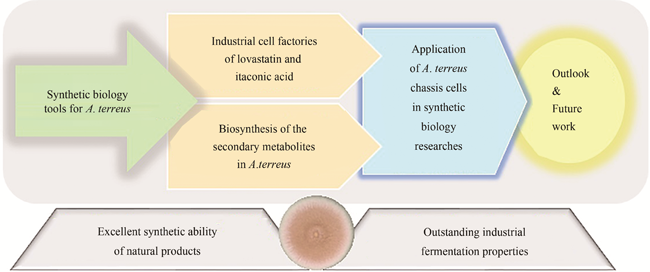Filamentous fungi are a class of important microorganisms, which have played an important role in the fields of industrial sectors and people's daily life for the production of food, medicine, and chemical products. With the development of synthetic biology, filamentous fungi have shown more potentials. Aspergillus terreus is an industrially valuable filamentous fungus, which has been applied in the production of the bio-based chemical itaconic acid and the lipid-lowering drug lovastatin. The excellent synthetic ability of natural products and outstanding fermentation properties of A. terreus have been fully demonstrated through industrial applications. Meanwhile, it has also been acknowledged that A. terreus would be a promising filamentous fungal chassis cell for synthetic biology development. In recent years, many studies have been performed using A. terreus, including genetic engineering of industrial strains, optimization of fermentation processes, elucidation of biosynthetic mechanisms, etc., which have significantly contributed to the development of A. terreus synthetic biology. Herewith, these recent research advances are reviewed from: 1) Synthetic biology tools for A. terreus. The development of genetic operation systems is introduced, including the characterization and application of promoters and markers and the progress of gene-editing technologies. 2) Industrial cell factory for the lipid-lowering drug lovastatin. In addition to the biosynthetic pathway of lovastatin, the design and construction of an efficient monacolin J-producing cell factory based on the industrial A. terreus strains are introduced in details. 3) Industrial cell factory for the bio-based chemical itaconic acid. The biosynthetic pathway of itaconic acid and the systematic metabolic engineering of the industrial strain are introduced. 4) Biosynthesis of secondary metabolites. The biosynthetic mechanism and research strategies for the secondary metabolites are introduced. 5) The advantages and prospects of A. terreus chassis cells in synthetic biology are summarized, and the practical applications are listed. Based on the research progress of A. terreus and other filamentous fungi, the challenges and future work of A. terreus biosynthesis technology development are proposed, including enriching the genetic element library, developing efficient gene editing methods and building high-throughput evaluation platforms. Addressing these challenges will provide more alternative design strategies for building more efficient cell factories of A. terreus, and will also contribute to promoting synthetic biology research of filamentous fungi.
